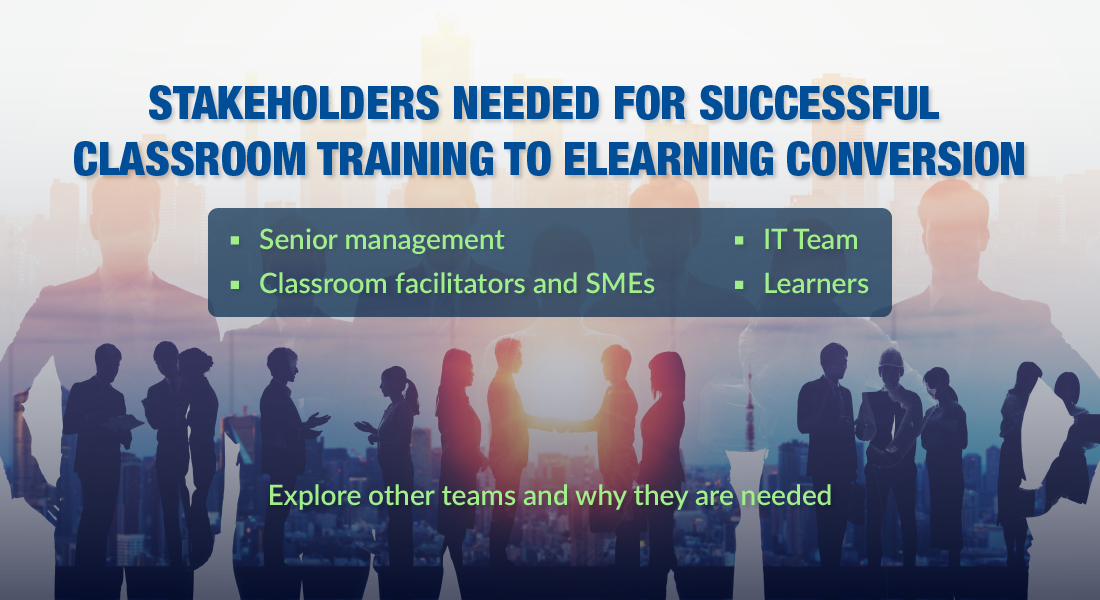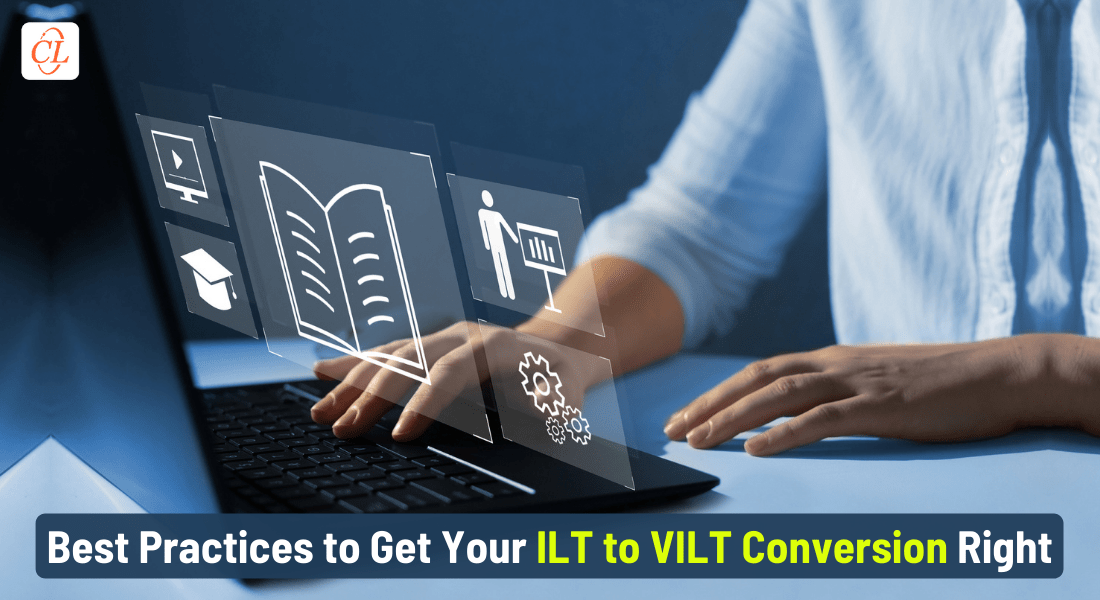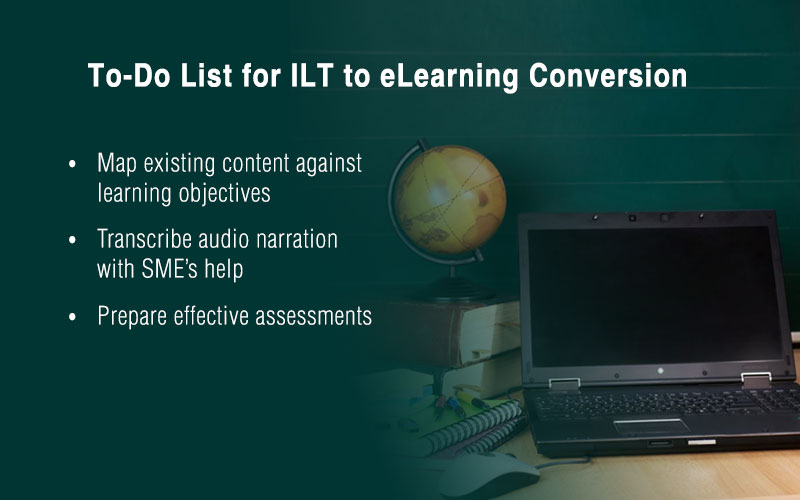5 Questions to Answer Before Converting Your ILT Resources to eLearning
There is lot more to this conversion process than simply converting PPTs to eLearning courses. In this post, we will look at five questions that will help organizations take control of their conversion project.

Despite its effectiveness and long-standing status as a tried-and-tested training approach, classroom training or instructor-led training (ILT) today is no longer enough by itself to adapt to modern learning demands. Modern learners of the twenty first century expect their training to do more than just train them, and this includes an anytime-anywhere access to learning content in just-in-time situations (on-the-go learning), and performance support among others.
The benefits of converting ILT material to eLearning, which are so evidently multi-fold, have caused many organizations to reconsider their training delivery formats. However, there is a lot more to this conversion process than simply converting PPTs to eLearning courses.
Organizations need to pay heed to important questions that directly influence how the conversion process will take shape. In this post, we will look at five such questions that will help organizations take control of their conversion project.
1. Do You Have a Strong Business Case for ILT Conversion?
There are a variety of reasons organizations invest in ILT to eLearning conversion. As an ideal alternative to classroom training, eLearning delivers many benefits over the traditional methods such as cost-effectiveness, learner-centric training, flexibility in learning, and much more. Before jumping the gun, however, it is important that organizations build a strong business case for the conversion.
Just like any other initiative, the success of converting your instructor-led training material to eLearning depends on the amount of traction you receive from the top management. Some of the aspects that you can include when preparing a business case are:
- Shortcomings of instructor-led training and how eLearning can supplement or complement the training
- The overall cost of implementing the conversion
- Drawing a comparison of the cost benefits that conversion can bring to the organization as opposed to traditional training methods
2. Which Components of ILT Do You Wish to Convert to eLearning?
Prior to initiating the conversion, organizations need to take some time to consider certain things about the different components that constitute the instructor-led training material. You must first determine what components can be retained to work within the ILT format and what components can be effective through eLearning.
Components that fulfil the criteria of conversion need to be identified and the right instructional strategies to offset challenges must be put in place as part of the online learning strategy.
3. Did You Eliminate Nice-to-Know from Need-to-Know Information?
Instead of converting classroom training material as-is to an eLearning format, layer the content into need-to-know information. Setting learning objectives is the way to achieve this layering of eLearning content. Learning objectives, in short, are specific and measurable statements that explain what learners will be able to do after completing a training program.
After the learning objectives are set, identify what is relevant content and remove the extraneous components. This picking and choosing of the content must be prioritized based on whether it is meeting the set learning objectives. Retaining the key elements in this form i.e., need-to-know as opposed to nice-to-know information makes the content crisp and easy for the learners to remember.
4. Have You Formulated an Instructional Strategy for Your Content?
Some ILT source material is instructionally designed but this does not warrant a direct conversion of the material to an eLearning format. As they venture into the conversion process, organizations still need to go through the steps that are involved in creating online learning.
For training to achieve the desired outcomes, content needs to be presented in a logical fashion, one that flows smoothly. To achieve this, organizations must choose an appropriate instructional strategy. In simple words, an instructional design strategy specifies how the [converted] content needs to be presented.
There are different instructional strategies depending upon the type of training being offered. These include guided learning, scenario-based learning, learning through exploration and discovery (LEAD), microlearning, game-based learning, among others.
5. What Authoring Tool to Use to Ensure a Smooth Conversion?
The choice of authoring tool plays a major role in the conversion process because the right tool will help organizations meet the technical and learning design requirements they have in mind. Most classroom training uses PDFs, PowerPoint presentations, and paper-based materials such as manuals and charts, among others.
While the manuals and charts are thoroughly analyzed and redesigned to create eLearning courses, PPTs can be directly imported to authoring tools and exported as online learning.
There exist several rapid authoring tools for ILT to eLearning conversion: if all you want are simple eLearning courses without any inflated interactive elements, then tools like iSpring can be used. However, if you are looking for courses with elaborate interactivities then tools such as Adobe Captivate, Articulate Storyline can come handy.
All the aforementioned rapid authoring tools are capable of creating device-agnostic courses which means they can be accessed on a wide range of devices such as smartphones and tablets.
While converting instructor-led training material to online learning is your ultimate goal, the process should not be about transcription. The objective of an organization must be that they use and leverage newer eLearning technologies and good instructional design practices in getting the conversion right.
All said and done, not every organization may be keen to completely convert their ILT to eLearning. For those organizations – who just want a portion of their traditional face-to-face instruction to be replaced by web-based online learning – blended learning is a good solution. By combining the best of both worlds, blended learning brings in the advantages of both ILT and e-learning.





